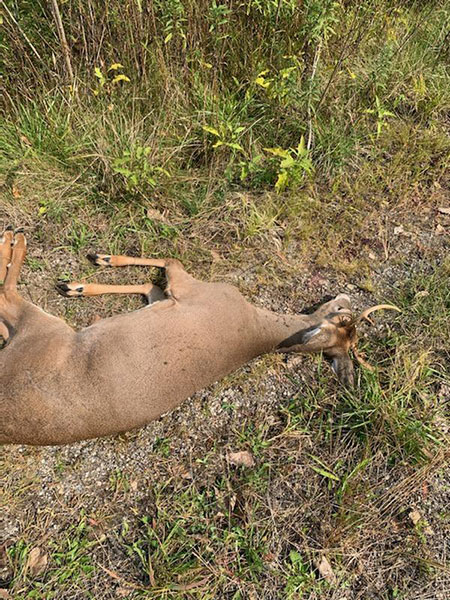By Louie Stout
 EHD Virus Killing Deer in Some Michiana Locales
EHD Virus Killing Deer in Some Michiana Locales
Dan Linn decided to check his trail cameras and deer stands in northwest St. Joseph County two weeks ago.
What he found was disheartening to any deer hunter. “When I got back to my hunting area I smelled something awful,” said the EMT for the Southwestern Michigan Community Ambulance Service. “I know what death smells like and my suspicions were confirmed.”
He soon came upon a dead, velvet-antlered, 10-point buck that showed no apparent injuries.
“I called a guy who hunts the property adjacent to mine,” Linn said. “He told me he had found dead deer on his property as well.”
Linn thought the deer were dying from EHD (Epizootic hemorrhagic disease) and got confirmation when he found another 7 dead deer at the watering hole near his property.
EHD is transmitted when a virus-carrying midge bites the animal. It causes high fever, hence dead deer often are found around water.
Linn reported it to the Indiana DNR, collected a sample from one of the fresh carcasses, and sent it to the DNR lab.
Indiana deer biologist Joe Caudell said last week that the lab results weren’t back but he suspected EHD as the cause.
“We get reports every year, but from what we can tell, St. Joseph County has a bigger portion of EHD this year than it has had in recent years,” Caudell said.
His office not only monitors reports of potential EHD outbreaks, but provides maps on the DNR website indicating where it has received reports. As of mid-week last week, there were 55 suspected cases in St. Joseph, 11 in LaPorte and 2 in Elkhart counties. As of Wednesday, there had been no reports from Marshall County.
You can find info on EHD and maps of infected areas at www.in.gov/dnr/fishwild/8541.htm.
Ken Kesson, Michigan southwest Michigan district wildlife biologist, said he’s heard of a few reports from his region as well.
“I’m not overly concerned at this point but we have received some reports,” he said. “With the weather shifting cooler, it should diminish.”
However, he added, he encourages hunters to report any dead deer they find by calling the DNR Service Center in Plainwell, 269-685-6851.
Southwest Michigan, specifically Cass County, was hit hard 10 years ago. An estimated 250 deer died of the virus in the county that year.
Like this year, Michiana experienced a hot, dry summer a decade ago. Those conditions lead to falling water levels around water holes and created muddy banks where the virus laden midges lay their eggs and multiply.
Caudell said Indiana manpower and financial resources don’t allow for testing of every deer that’s reported. The DNR tries to sample one or two samples from each county when possible.
“Once we get confirmation in an area and hunters report more deer in that area, we can pretty well know that EHD was the cause,” Caudell explained.
Outbreaks tend to be spotty and often don’t affect the herd outside the hotspot. The virus is spread by the midge and not from deer to deer.
Hunters who find dead deer are encouraged to report them online, www.in.gov/dnr/fishwild/10446.htm. You will be asked to leave your contact information along with the details of where and when you found the deer. If necessary, a DNR employee will contact you.
There is no evidence that humans can get EHD or are affected by eating a deer with the virus.
“We see deer that hunters have harvested that were carrying the virus,” he said.
One of the most common characteristic of an EHD infected deer is damaged or broken hooves. Other signs are swelling around the head and neck, excessive salivation, rosy or bluish color of the mouth and tongue, or loss of wariness and signs of physical weakness. Deer can appear ill for weeks and some will recover.




